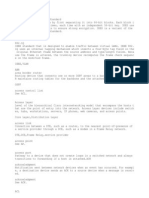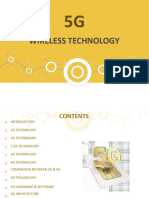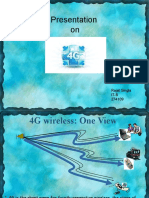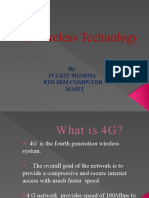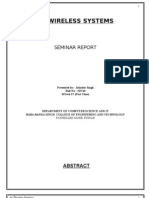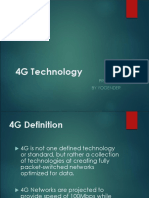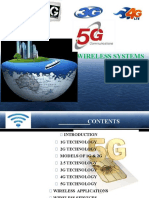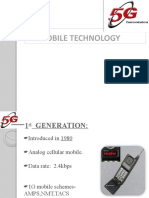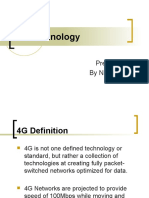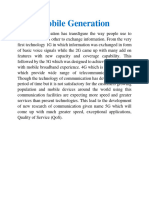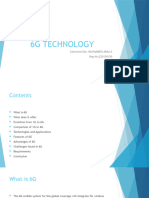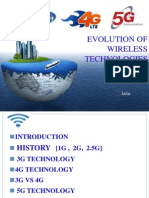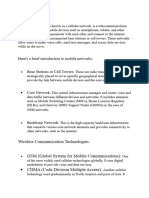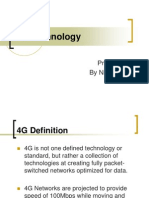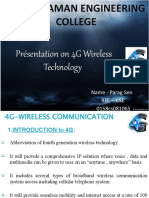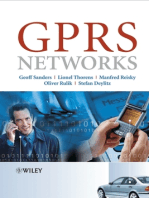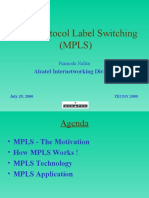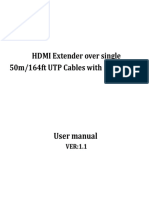4g Communication Remake
4g Communication Remake
Uploaded by
SangeethaDuraisamyOriginal Description:
Copyright
Available Formats
Share this document
Did you find this document useful?
Is this content inappropriate?
Report this DocumentCopyright:
Available Formats
4g Communication Remake
4g Communication Remake
Uploaded by
SangeethaDuraisamyCopyright:
Available Formats
Designed By
Balasubramaniyan.R
4g mobile communication
High speed data rates at 20 to 100 Mbps.
Anytime,Anywhere connection also known as
"Mobile Broadband Everywhere".
MAGIC-Mobile multimedia Communication
Anytime,Anyone Global mobilitysupport integrated
wirelesssolution customized personal service.
4g mobile communication
1G MOBILE COMMUNICATION
1G was an analog system, and was developed in the
seventies.
The basic cellular structure of mobile
communication.
1G is used primarily for voice communications.
EVOLUTION OF MOBILE
COMMUNICATION
"If you can dream it, you can do it", according
to this we can leap 3G to 4G along its features
and future trends in mobile technology. In
wireless communication, mobile technology is
advanced and in this system 4G is the latest at
present.
WHAT IS 4G?
Wirelessbroadband connectivity,designed primarily for data
transport versus voice networks pulling double-duty as data
movers.
Faster and more reliable 100 Mb/s
Lower cost than previous generation . IPv6 Core .
Multi-standard wireless system Bluetooth, Wired,
Wireless
OFDM is used.
IEEE standard 802.11
1G MOBILE COMMUNICATION
1G was an analog system, and was developed in the
seventies.
The basic cellular structusre of mobile
communication.
1G is used primarily for voice communication.
Poor voice quality,
Poor battery life,
Large phone size,
No security,
Frequent call drops,
Limited capacity and Poor handoff reliability
2G MOBILE COMMUNICATION
Circuit switched, developed in 1980s.
Voice transmission and reception.
2.5G- as a stepping stone to 3G.
2G -GSM service.
2.5G -GPRS along with GSM.
DRAMBACKS BY 2G
Inefficiency in usage of bandwidth.
GSM- do not support high data rates.
3G MOBILE
COMMUNICATION
3G adds multimedia facilities to 2G phones,developed
in late 2002 & 2003.
GLOBAL ROAMING.
Wide Band Voice Channel.
Clarity of voice .
DRAWBACKS BY 3G;
High bandwidth requirement
High spectrum licensing fees
Huge capital
4G MOBILE COMMUNICATION
Characterized by high-speed data rates at 20 to 100
Mbps.
Suitable for high-resolution movies and television,
virtual
The "next dimension" of wireless communication.
Mobile speed -200km/hr.
Frequency band is 2-8 GHz.
Ability for worldwide roaming to access cell
anywhere.
Network of Networks.
4G LAYERED ARCHITECTURE
Design of algorithms
that will lead to flexible
air interface ,while
decreasing the terminal
complexity.
Cheaper and deliver high
quality of service than
3G.
FDMA,TDMA&CDMA
FDMA:
Spectrum is cut into different frequencies.
Used in 1G.
Large bandwidth wastage.
TDMA:
Splitting the slots by time.
Used in 2G.
CDMA:
Allow user to sit on all frequencies at the same time &
each cell is identified by unique code.Bandwidth efficient.
4G PRINCIPLE
TECHNOLOGIES
OFDM
UWB
SMART ANTENNAS
LONG TERM POWER PREDICTION
SHEDULING AMONG USERS
ADAPTIVE MODULATION AND POWER
CONTROL
FEATURES OF 4G
Support for interactive multimedia,.
IP based mobile system.
High speed, high capacity, and low cost-per-bit.
Seamless switching and a variety of QoS services
Better scheduling and call-admission-control
techniques,spectral efficiency.
Seamless network of multiple protocols and air interfaces
An infrastructure to handle pre-existing 3G systems along
with other wireless technologies.
COMPARISON OF 3G &4G
Attribute 3G 4G
Frequency 1.6-2.5GHz 2-8GHz
Data Rate 385Kbps-2Mbps 20-100Mpbs
Access WCDMA/CDMA2
000
MC_CDMA/OFD
M
Switching Circuit/Packet Packet
Bandwidth 5-20MHz 100+MHz
Component
Design
Optimized
antenna,multi
band adapters
Smart
antenna,SW
multiband,
wideband
radios
advantages and
disadvantages of 4g
Advantages:
High usability: anytime, anywhere, and with any
technology.
Support for multimedia services at low transmission cost.
Higher bandwidth, tight network security.
Disadvantages:
The equipment required to implement a next generation
network is still very expensive. Carriers and providers
have to plan carefully to make sure that expenses are kept
realistic.
CONCLUSION
Low cost high speed data will drive forward the fourth
generation (4G) as short- range communication emerges.
It is probable that the radio access network will evolve
from a centralized architecture to a distributed one.
4G is likely to enable the download of full length songs or
music pieces which may change the market response
dramatically.
Innovations in network technology will provide an
environment in which virtually anything is available,
anywhere, at any time, via any connected device.
THANK YOU
You might also like
- 5g TechnologyDocument15 pages5g Technologysushmachinnu100% (1)
- 5G TechnologyDocument25 pages5G TechnologyHarishReddy100% (1)
- Essential 4G Guide: Learn 4G Wireless In One DayFrom EverandEssential 4G Guide: Learn 4G Wireless In One DayRating: 4.5 out of 5 stars4.5/5 (12)
- GlossaryDocument107 pagesGlossaryPeter GraphicsNo ratings yet
- NGMN Whitepaper LTE Backhauling Deployment Scenarios 01 PDFDocument34 pagesNGMN Whitepaper LTE Backhauling Deployment Scenarios 01 PDFBeny D SetyawanNo ratings yet
- Home Software Hardware Support Downloads Purchase Training: AccountDocument7 pagesHome Software Hardware Support Downloads Purchase Training: Accountangelo68000No ratings yet
- Presented by Sushil SudakeDocument21 pagesPresented by Sushil SudakeAbdou Dabado ObadoNo ratings yet
- Wireless TechnologyDocument36 pagesWireless Technologyraelpogi4No ratings yet
- Presentation On: Rajat Singla It-B 274109Document25 pagesPresentation On: Rajat Singla It-B 274109Garima KapoorNo ratings yet
- Presentation On 4G Wireless TechnologyDocument60 pagesPresentation On 4G Wireless TechnologycheezeshaNo ratings yet
- PulkitDocument18 pagesPulkitPulkit SharmaNo ratings yet
- Presented By: Suresh Kumar.VDocument16 pagesPresented By: Suresh Kumar.VsurivskNo ratings yet
- Abstract On 5gDocument7 pagesAbstract On 5gGaurav Mishra100% (2)
- Wirelesstechnology10 161106084607Document33 pagesWirelesstechnology10 161106084607Geetesh NNo ratings yet
- 4G TechnologyDocument28 pages4G Technologyarpit109100% (3)
- Lect 2 2k21Document51 pagesLect 2 2k21akbartayyaba09No ratings yet
- Ict ReportDocument13 pagesIct ReportSANTOSH GAIKWADNo ratings yet
- Technical Seminar: S V Suresh 08731A1254Document14 pagesTechnical Seminar: S V Suresh 08731A1254Shyam YadavNo ratings yet
- 5G Mobile Technology: Presented by A.PriyankaDocument18 pages5G Mobile Technology: Presented by A.PriyankaHarsha Vardhan TholetiNo ratings yet
- 4g Wireless SystemsDocument29 pages4g Wireless SystemsGajendra ShankhwarNo ratings yet
- 4g Wireless TechnologyDocument25 pages4g Wireless Technologykrmukesh100% (1)
- Paper Presentation On 4G Technology: Presented by K.CHARISHA& K.Ganga Bhavani B.Tech, ECE III YearDocument7 pagesPaper Presentation On 4G Technology: Presented by K.CHARISHA& K.Ganga Bhavani B.Tech, ECE III YearGanga BhavaniNo ratings yet
- 5g Mobile TechnologyDocument6 pages5g Mobile TechnologyVikas KapoorNo ratings yet
- 4G Technology: Presented by YogenderDocument26 pages4G Technology: Presented by YogenderPawanJainNo ratings yet
- 5G Network TechnologiesDocument17 pages5G Network TechnologiesAlbert WangNo ratings yet
- ElectronicsDocument31 pagesElectronicsMadhu GaneshNo ratings yet
- A Paper Presentation ON: Magic CommunicationDocument16 pagesA Paper Presentation ON: Magic CommunicationMohammed FaizanNo ratings yet
- 4G Technology: SLC'S Institute of Engg and TechnologyDocument9 pages4G Technology: SLC'S Institute of Engg and TechnologySIVA KRISHNA PRASAD ARJANo ratings yet
- PP Lab 5g TecDocument36 pagesPP Lab 5g TecOppo Y 15No ratings yet
- Technology Better Internet: Wireless SystemDocument15 pagesTechnology Better Internet: Wireless SystemAvinash PalavaiNo ratings yet
- 5G Mobile TechnologyDocument16 pages5G Mobile TechnologyGeorge HelmyNo ratings yet
- 3G and 4G PresentationDocument18 pages3G and 4G PresentationGaurav KathuriaNo ratings yet
- 5g TechnologyDocument20 pages5g TechnologyChristin Ps100% (1)
- BY Upasana GaikwadDocument30 pagesBY Upasana GaikwadRenu YadavNo ratings yet
- 4G Technology: Presented M.RajuDocument26 pages4G Technology: Presented M.RajuShital Solanki MakwanaNo ratings yet
- 4G Technology: Presented by Nithin RajDocument26 pages4G Technology: Presented by Nithin RajLucasNo ratings yet
- 2Document74 pages2KavinNo ratings yet
- 4G Technology: Presented by Nithin RajDocument26 pages4G Technology: Presented by Nithin RajClaudiu MădălinNo ratings yet
- Mobile Generation222Document16 pagesMobile Generation222AHMEDNo ratings yet
- 5G Technology: Danish Amin & MD ShahidDocument25 pages5G Technology: Danish Amin & MD ShahidRam PadhiNo ratings yet
- Abstract of 4G NETWORKSDocument1 pageAbstract of 4G NETWORKSprahba_sat112No ratings yet
- 4G Technology: Presented Rahul SainiDocument26 pages4G Technology: Presented Rahul SainiPrabhat SharmaNo ratings yet
- 6g Technology Slide AnasDocument19 pages6g Technology Slide AnasanildesignsflexNo ratings yet
- 5g Mobile TechnologyDocument13 pages5g Mobile TechnologyAshish NimawatNo ratings yet
- Avinash Gourav Divaya HeenaDocument14 pagesAvinash Gourav Divaya HeenanrjchopraNo ratings yet
- History of Mobile CommunicationDocument25 pagesHistory of Mobile Communicationnenz187100% (1)
- 4G Seminar ReportDocument31 pages4G Seminar ReportFazil AliNo ratings yet
- 4G Technology: Presented by Nithin RajDocument26 pages4G Technology: Presented by Nithin RajEngyEmyNo ratings yet
- 4G Wireless Systems: Yuben JosephDocument8 pages4G Wireless Systems: Yuben JosephHashmi EugineNo ratings yet
- DCC MicroprojectDocument19 pagesDCC Microprojectmohiteshreya203No ratings yet
- 4g TechnologyDocument16 pages4g Technologyapi-422183469No ratings yet
- 5 GDocument26 pages5 GRani ManugrahaniNo ratings yet
- Wireless SystemDocument12 pagesWireless SystemMonika VermaNo ratings yet
- Seminar On 4G Technology: Prensented byDocument19 pagesSeminar On 4G Technology: Prensented byAdityansh UpadhyayNo ratings yet
- ACN Assign - Jyotimoi - I079 PDFDocument12 pagesACN Assign - Jyotimoi - I079 PDFJyotimoiHazarikaNo ratings yet
- 4G Technology: Presented by Nithin RajDocument26 pages4G Technology: Presented by Nithin RajMayank SharmaNo ratings yet
- 4G Technology: Presented by Akshay RathoreDocument26 pages4G Technology: Presented by Akshay RathoreRaj MohanNo ratings yet
- 3G To 4G Beyond 5GDocument12 pages3G To 4G Beyond 5GSomendra PrabhakarNo ratings yet
- Radharaman Engineering College: Présentation On 4G Wireless TechnologyDocument26 pagesRadharaman Engineering College: Présentation On 4G Wireless TechnologyParag SenNo ratings yet
- The 5G Revolution: How the Next Generation of Wireless Will Change EverythingFrom EverandThe 5G Revolution: How the Next Generation of Wireless Will Change EverythingNo ratings yet
- The Power of TETRA-Direct Mode Operation-Selex Communications Francesco PasqualiDocument29 pagesThe Power of TETRA-Direct Mode Operation-Selex Communications Francesco PasqualiRatchaneekorn Mo-onNo ratings yet
- AIS1900 Transponder Technical ManualDocument96 pagesAIS1900 Transponder Technical ManualWijang PrastowoNo ratings yet
- DBXLH 6565B VTMDocument4 pagesDBXLH 6565B VTMCésar Antonio Sandoval Reyes100% (1)
- Basic Commands On Alcatel OmniswitchDocument7 pagesBasic Commands On Alcatel OmniswitchWashington SombraNo ratings yet
- Ine Vo DD WB Vol1 Mod8 GK TasksDocument3 pagesIne Vo DD WB Vol1 Mod8 GK TasksMagicianReconNo ratings yet
- Quadrature Amplitude Modulation - Wikipedia, The Free EncyclopediaDocument8 pagesQuadrature Amplitude Modulation - Wikipedia, The Free Encyclopediaselp_gantenk2804No ratings yet
- CA. 7.1 Cloud Computing (17-18)Document16 pagesCA. 7.1 Cloud Computing (17-18)Kaushal KapureNo ratings yet
- Using Watlow Products With Specview: Addendum To Specview ManualDocument46 pagesUsing Watlow Products With Specview: Addendum To Specview ManualCristianNo ratings yet
- Gigabyte Ga b85m Ds3h A r10 PDFDocument30 pagesGigabyte Ga b85m Ds3h A r10 PDFMartha Lorena TijerinoNo ratings yet
- Teamlink Fabio-2Cx User Manual: Team Engineers Advance Technologies India. Pvt. LTDDocument17 pagesTeamlink Fabio-2Cx User Manual: Team Engineers Advance Technologies India. Pvt. LTDrajasankarNo ratings yet
- Multiprotocol Label Switching (MPLS) : Alcatel Internetworking DivisionDocument35 pagesMultiprotocol Label Switching (MPLS) : Alcatel Internetworking Divisionpankajaggarwal805283No ratings yet
- Pa 220rDocument2 pagesPa 220rasadaNo ratings yet
- Hybrid Approach For Data Aggregation in WSN With Advance Security Protocol inDocument7 pagesHybrid Approach For Data Aggregation in WSN With Advance Security Protocol inrahul sharmaNo ratings yet
- Date Time Branch SubjectDocument4 pagesDate Time Branch SubjectPriyanka YadavNo ratings yet
- Brochure Master GEEDocument2 pagesBrochure Master GEEvenvettyNo ratings yet
- Future of 5gDocument35 pagesFuture of 5gBinay Prasad100% (3)
- BRKDCN 3346Document161 pagesBRKDCN 3346Rakesh KumarNo ratings yet
- 5G Installation - RSA ChecklistsDocument70 pages5G Installation - RSA ChecklistsYounus DarNo ratings yet
- Clockless ChipDocument20 pagesClockless ChipRamireddy Gangadhar ReddyNo ratings yet
- RRU3971 DescriptionDocument16 pagesRRU3971 DescriptionMohammad AlswilemNo ratings yet
- User Manual: HDMI Extender Over Single 50m/164ft UTP Cables With IR ControlDocument12 pagesUser Manual: HDMI Extender Over Single 50m/164ft UTP Cables With IR ControlSergio GrañaNo ratings yet
- Lotus Notes and Domino Security r5.0Document300 pagesLotus Notes and Domino Security r5.0Ilija ZelenikaNo ratings yet
- Trust Wallet Development - MobiloitteDocument1 pageTrust Wallet Development - MobiloitteMobiloitte TechnologiesNo ratings yet
- Palo Alto Networks VMware Workstation 10.0 Academy Lab Deployment GuideDocument36 pagesPalo Alto Networks VMware Workstation 10.0 Academy Lab Deployment Guidedr.suppakarnNo ratings yet
- Online Safety, Security, Ethics, and Etiquette: Prepared By: Mark Jhon OxilloDocument31 pagesOnline Safety, Security, Ethics, and Etiquette: Prepared By: Mark Jhon OxilloRichelle RiboNo ratings yet
- Patch ReportDocument48 pagesPatch ReportAdegboye OlaoluwaNo ratings yet




